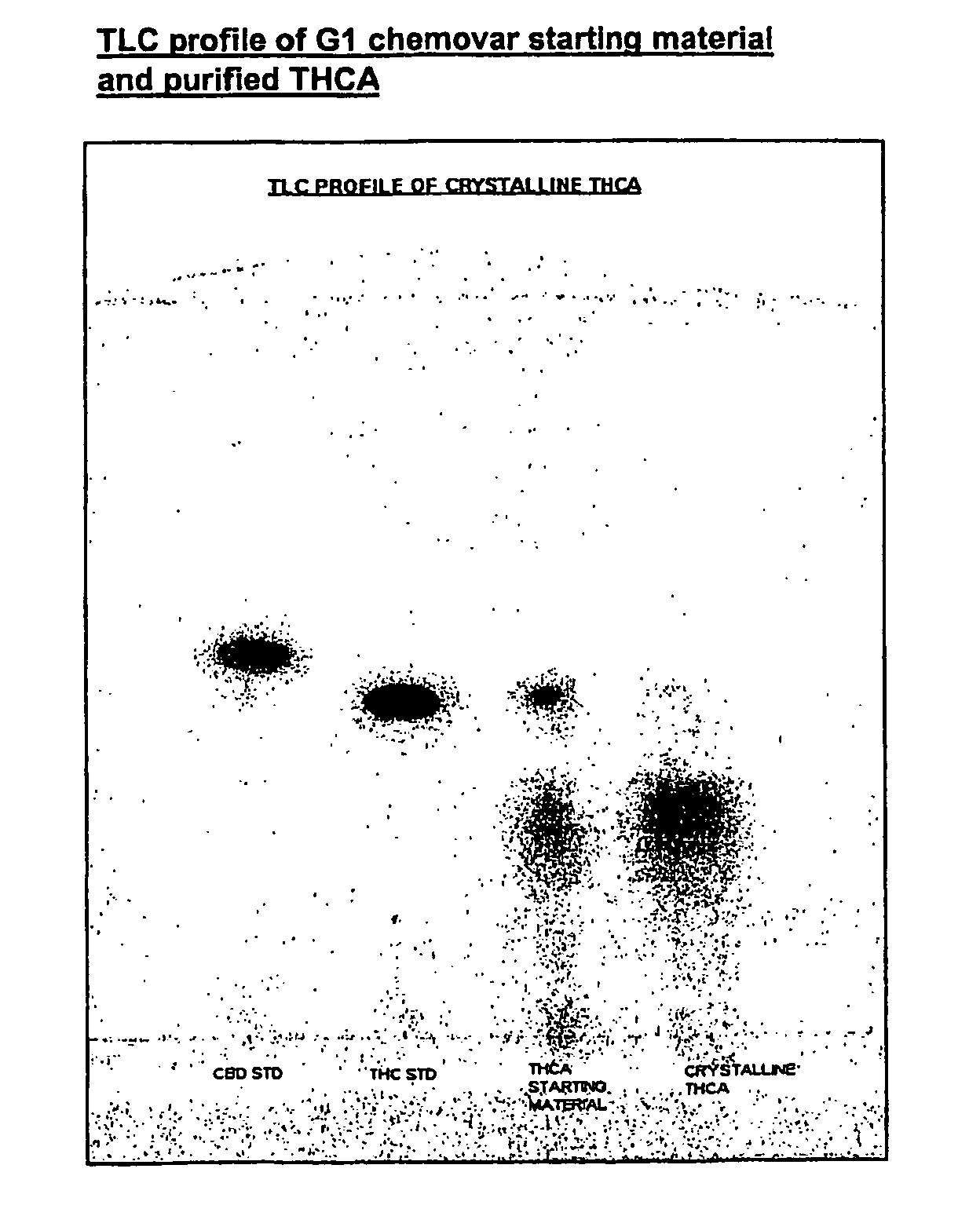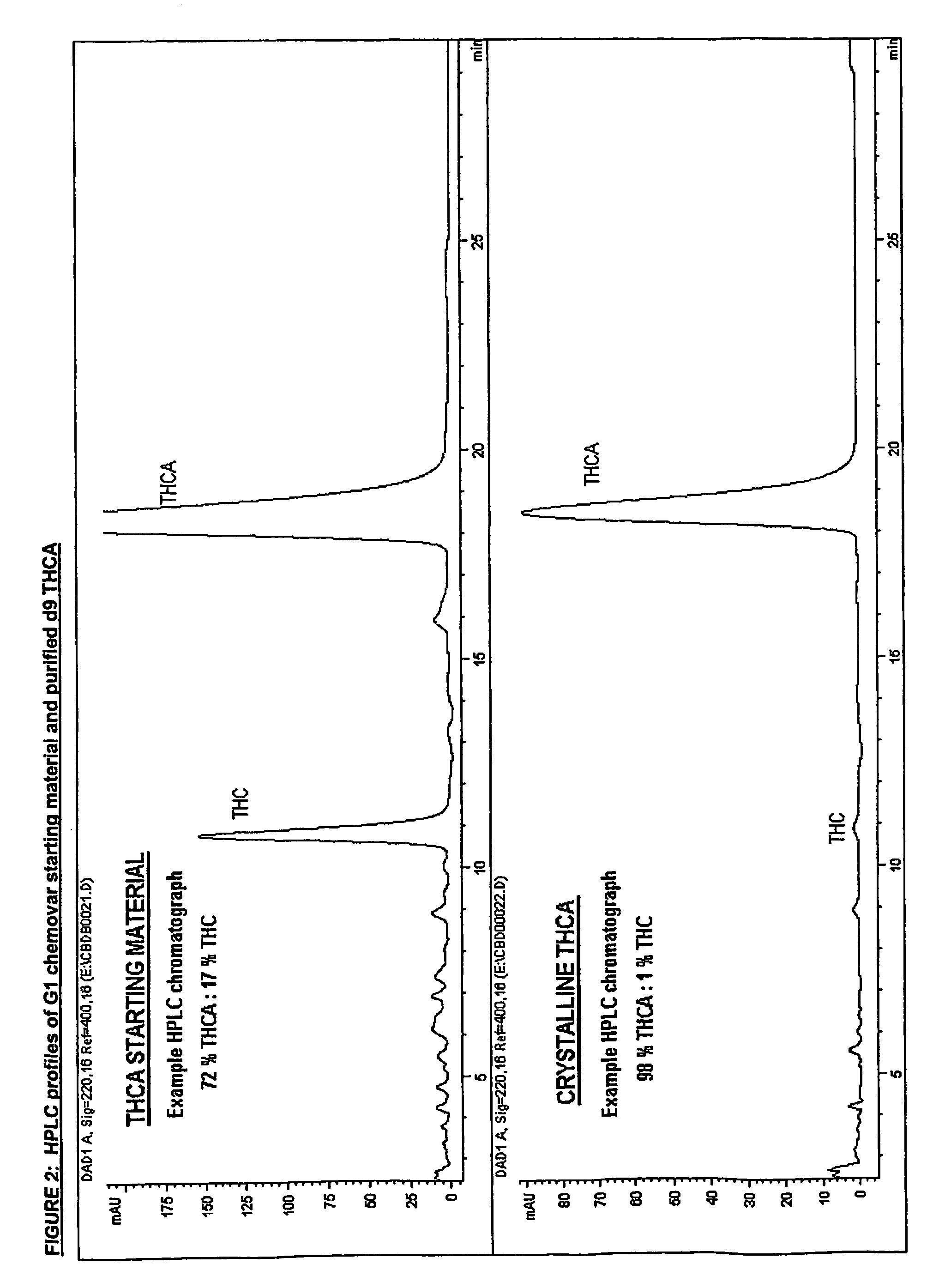Methods of purifying cannabinoids from plant material
a technology of plant material and cannabinoids, which is applied in the field of purifying cannabinoids, can solve the problems of restricted investigation of the pharmacology of these compounds, high cost of synthetic cannabinoids, and unknown true therapeutic potential
- Summary
- Abstract
- Description
- Claims
- Application Information
AI Technical Summary
Benefits of technology
Problems solved by technology
Method used
Image
Examples
example 1
Preparation of Δ9 THCA
Summary of Process:
Extract THC herb (G1 chemovar) with 0.1% v / v acetic acid in hexane.
↓
Filter and remove solvent from filtrate on rotary evaporator.
↓
Pass a solution of the resulting THCA enriched extract through a column packed with Sephadex LH2O, eluting with 2:1 chloroform / dichloromethane.
↓
Collect THCA rich fractions and remove solvent by rotary evaporation.
↓
Re-dissolve crude THCA in methanol and remove insoluble residue by filtration.
↓
Remove solvent from filtrate by rotary evaporation.
↓
Re-dissolve crude THCA in pentane and remove insoluble residue by filtration.
↓
Remove solvent from filtrate by rotary evaporation.
↓
Δ9 THCA crystals
Results:
[0198]Yield:
[0199]100 g of G1 chemovar yields approx 5 g of purified Δ9 THCA
Characteristics:
[0200]Pale yellow crystalline solid.
[0201]Chromatographic purity=98% by area normalization.
CBD<0.5% w / w
THC=1.0% w / w
CBN<1.0% w / w
[0202]Melting point=70° C. (with decomposition).
[0203]Material slowly decarboxylates in solution
Δ9 THCA→Δ9 T...
example 2
Preparation of CBDA
Summary of Process:
Extract CBD herb (G5 chemovar) with 0.1% v / v acetic acid in hexane.
↓
Filter and remove solvent from filtrate on rotary evaporator.
↓
Pass a solution of the resulting CBDA enriched extract through a column packed with Sephadex LH20, eluting with 2:1 chloroform / dichloromethane.
↓
Collect CBDA rich fractions and remove solvent by rotary evaporation.
↓
Re-dissolve crude CBDA in methanol and remove insoluble residue by filtration.
↓
Remove solvent from filtrate by rotary evaporation.
↓
Re-dissolve crude CBDA in pentane and remove insoluble residue by filtration.
↓
Remove solvent from filtrate by rotary evaporation.
↓
i) CBDA crystals or ii) CBDA solution
For i) above:
Yield:
[0204]100 g of G5 chemovar yields approx 5 g of purified CBDA.
Characteristics:
[0205]Pale yellow crystalline solid
[0206]Melting Point=45-48° C.
[0207]Chromatographic purity=94% CBDA by area normalisation with reference to FIG. 4
*CBD 3%.
THCA non detected i.e. <0.1%
[0208]THC non detected i.e. <0.1% * ...
example 3
Preparation of Δ9 THC
Summary of Process:
Ethanolic solution of BDS (approx 400 mg / ml) passed through a column of activated charcoal, and eluate collected.
↓
Remove solvent by rotary evaporation to give THC enriched fraction.
↓
Pass a solution of the resulting THC enriched extract through a column packed with Sephadex LH2O, eluting with 2:1 chloroform / dichloromethane.
↓
Collect THC rich fractions and remove solvent by rotary evaporation.
↓
Re-dissolve crude THC in methanol and remove insoluble residue by filtration.
↓
Remove solvent from filtrate by rotary evaporation.
↓
Re-dissolve crude THC in pentane and remove insoluble residue by filtration.
↓
Remove solvent from filtrate by rotary evaporation.
↓
Δ9 THC SEMI-SOLID
Yield:
[0213]3.5 g of Δ9 THC BDS yields approx 1.5 g of purified Δ9 THC.
Characteristics:
[0214]Clear semi-solid which rapidly takes on a purple colour when exposed to air.
[0215](This colour change is reversible when the material is redissolved in a suitable solvent).
[0216]Chromatographic ...
PUM
| Property | Measurement | Unit |
|---|---|---|
| chromatographic purity | aaaaa | aaaaa |
| chromatographic purity | aaaaa | aaaaa |
| chromatographic purity | aaaaa | aaaaa |
Abstract
Description
Claims
Application Information
 Login to View More
Login to View More - R&D
- Intellectual Property
- Life Sciences
- Materials
- Tech Scout
- Unparalleled Data Quality
- Higher Quality Content
- 60% Fewer Hallucinations
Browse by: Latest US Patents, China's latest patents, Technical Efficacy Thesaurus, Application Domain, Technology Topic, Popular Technical Reports.
© 2025 PatSnap. All rights reserved.Legal|Privacy policy|Modern Slavery Act Transparency Statement|Sitemap|About US| Contact US: help@patsnap.com



